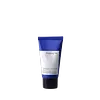What's inside
What's inside
 Key Ingredients
Key Ingredients

No key ingredients
 Benefits
Benefits

 Concerns
Concerns

 Ingredients Side-by-side
Ingredients Side-by-side

Water
Skin ConditioningCyclomethicone
EmollientAlcohol
AntimicrobialButylene Glycol
HumectantNiacinamide
SmoothingGlycerin
HumectantCyclopentasiloxane
EmollientDimethicone Crosspolymer
Emulsion StabilisingTrehalose
HumectantSodium Hyaluronate
HumectantPolysorbate 20
EmulsifyingTriethanolamine
BufferingCarbomer
Emulsion StabilisingBis-PEG-18 Methyl Ether Dimethyl Silane
EmollientXanthan Gum
EmulsifyingLecithin
EmollientUrsolic Acid
MaskingAtelocollagen
Skin ConditioningSodium Chondroitin Sulfate
Skin ConditioningHamamelis Virginiana Leaf Extract
Skin ConditioningCitrullus Lanatus Fruit Extract
Skin ConditioningOcimum Basilicum Leaf Extract
Skin ConditioningNelumbo Nucifera Flower Extract
Skin ConditioningSea Water
HumectantBetula Platyphylla Japonica Juice
Skin ConditioningHydrolyzed Corallina Officinalis Extract
Skin ConditioningHoney Extract
HumectantBiosaccharide Gum-1
HumectantSodium PCA
HumectantBetaine
HumectantSorbitol
HumectantGlycine
BufferingAlanine
MaskingProline
Skin ConditioningSerine
MaskingThreonine
Arginine
MaskingLysine
Skin ConditioningGlutamic Acid
HumectantOlea Europaea Fruit Oil
MaskingGlycyrrhiza Glabra Root Extract
BleachingBroussonetia Kazinoki Callus Culture Extract
Skin ConditioningDisodium EDTA
Caprylyl Glycol
EmollientEthylhexylglycerin
Skin ConditioningTropolone
Skin ConditioningCI 19140
Cosmetic ColorantCI 42090
Cosmetic ColorantParfum
MaskingWater, Cyclomethicone, Alcohol, Butylene Glycol, Niacinamide, Glycerin, Cyclopentasiloxane, Dimethicone Crosspolymer, Trehalose, Sodium Hyaluronate, Polysorbate 20, Triethanolamine, Carbomer, Bis-PEG-18 Methyl Ether Dimethyl Silane, Xanthan Gum, Lecithin, Ursolic Acid, Atelocollagen, Sodium Chondroitin Sulfate, Hamamelis Virginiana Leaf Extract, Citrullus Lanatus Fruit Extract, Ocimum Basilicum Leaf Extract, Nelumbo Nucifera Flower Extract, Sea Water, Betula Platyphylla Japonica Juice, Hydrolyzed Corallina Officinalis Extract, Honey Extract, Biosaccharide Gum-1, Sodium PCA, Betaine, Sorbitol, Glycine, Alanine, Proline, Serine, Threonine, Arginine, Lysine, Glutamic Acid, Olea Europaea Fruit Oil, Glycyrrhiza Glabra Root Extract, Broussonetia Kazinoki Callus Culture Extract, Disodium EDTA, Caprylyl Glycol, Ethylhexylglycerin, Tropolone, CI 19140, CI 42090, Parfum
Ingredients Explained
These ingredients are found in both products.
Ingredients higher up in an ingredient list are typically present in a larger amount.
Butylene Glycol (or BG) is used within cosmetic products for a few different reasons:
Overall, Butylene Glycol is a safe and well-rounded ingredient that works well with other ingredients.
Though this ingredient works well with most skin types, some people with sensitive skin may experience a reaction such as allergic rashes, closed comedones, or itchiness.
Learn more about Butylene GlycolGlycerin is already naturally found in your skin. It helps moisturize and protect your skin.
A study from 2016 found glycerin to be more effective as a humectant than AHAs and hyaluronic acid.
As a humectant, it helps the skin stay hydrated by pulling moisture to your skin. The low molecular weight of glycerin allows it to pull moisture into the deeper layers of your skin.
Hydrated skin improves your skin barrier; Your skin barrier helps protect against irritants and bacteria.
Glycerin has also been found to have antimicrobial and antiviral properties. Due to these properties, glycerin is often used in wound and burn treatments.
In cosmetics, glycerin is usually derived from plants such as soybean or palm. However, it can also be sourced from animals, such as tallow or animal fat.
This ingredient is organic, colorless, odorless, and non-toxic.
Glycerin is the name for this ingredient in American English. British English uses Glycerol/Glycerine.
Learn more about GlycerinPolysorbate 20 is made by combining ethoxylation of sorbitan, ethylene oxide, and lauric acid. It is a mild cleansing agent, surfactant, and emulsifier.
As a surfactant, it helps collect dirt and oils for washing. Emulsifiers prevent oils and water from separating.
Polysorbate 20 also adds scent to a product. Since it is made using sorbitol, it has a sweet scent. Sorbitol can also be found in fruits such as apples and peaches.
The lauric acid used to create Polysorbate 20 is often derived from coconuts.
Polysorbate 20 may not be fungal acne safe.
Learn more about Polysorbate 20